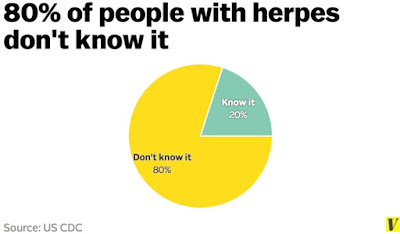 |
| https://c1.staticflickr.com/9/8233/28295539863_f00c68a306_b.jpg |
The WHO estimated that half a billion
people worldwide aged 15-49 years have genital infection caused by Herpes
virus. In USA, nearly one out of six people aged 14 to 49 years have it.[1]
Globally,
WHO estimated that two-thirds of the
population under 50 are infected with herpes simplex virus type 1.[2]
 |
| plannedparenthood.org |
Genital
herpes is caused by two type of viruses, Herpes simplex type1(HSV-1) and Herpes
Simplex type 2 (HSV-2), a virus that almost exclusively causes genital
infections. HSV-1 is a closely related virus that causes both oro-labial
herpes (“cold sores”) and genital herpes.[3]
The US Preventative Services Task Force
(USPSTF) released an evidence statement and updated it’s 2005
recommendation on serological screening for genital herpes online on December
20, 2016 in JAMA and its own website.
The USPSTF recommends against routine serologic
screening for genital herpes simplex virus (HSV) infection in asymptomatic
adolescents and adults, including those who are pregnant.
Screening is indicated for certain high risk groups
like men who have sex with men and HIV positive individuals.
After thorough review of evidence, USPSTF concluded
that harms of screening outweigh the benefits because the current serological
test used gives large number of false positive results and no confirmatory test
is widely available.
 |
| CDC.org |
Ann E.
Kurth, PhD, MPH, a task force member said in a USPSTF news release “Despite
genital herpes being common, testing is not generally helpful for people
without symptoms, in part because early identification does not improve a
person's health as there is no cure for herpes.” She further added “In addition,
because current screening methods are often inaccurate, harms of screening
include high false-positive rates and potential anxiety and disruption of
personal relationships related to diagnosis."
Currently HerpeSelect® (Focus Diagnostics, Cypress,
CA) is the most widely used FDA approved enzyme immunoassay for the qualitative
detection of type specific HSV-2 IgG with sensitivity of 97 to 100% and
specificity of 72 to 91%.
"Given the test characteristics of the most
widely used serologic screening test for HSV-2 and a population infection
prevalence of 15 percent, screening 10,000 people would result in approximately
1,485 true-positive and 1,445 false-positive results," the final
recommendation statement said.[4]
False positive results lead to emotional and mental
trauma along with unnecessary treatment with antiviral medications.
Diagnostic testing is indicated in persons who have
recurrent HSV infection or belong to certain high risk groups like persons
living with HIV infection.
The task force clarified its stand about HSV-1
infection, noting that although HSV-1 infection can be identified by serologic
tests, the tests cannot determine if the site of infection is oral or genital.
The USPSTF recommends intensive behavioral counseling
interventions to reduce the likelihood of acquiring a sexually transmitted
infection for all sexually active adolescents and for adults at increased risk.
The USPSTF has also issued recommendations on screening for other sexually
transmitted infections, including chlamydia and gonorrhea, hepatitis B virus,
HIV, and syphilis.
The American Academy of Family Physicians, the
American College of Obstetricians and Gynecologists (ACOG), and the CDC do not
recommend routine serologic screening for genital HSV infection in asymptomatic
adolescents or adults.
The AAFP released its own recommendations that
mirror the USPSTF statement.
In an accompanying editorial in JAMA by Edward
W. Hook III, MD, School of Medicine, Department of
Microbiology, The University of Alabama at Birmingham, calls for improving
performance of new and currently available tests.
He also acknowledged the lack of progress in test
performance since the last USPSTF update in 2005. “The current USPSTF
recommendation should serve to renew efforts to develop better tests for HSV,
to improve management strategy, and to address the pervasive and harmful stigma
associated with genital herpes," he concludes.
Link to the full article -http://jamanetwork.com/journals/jama/fullarticle/2593575
Link to the accompanying editorial -http://jamanetwork.com/journals/jama/article-abstract/2593550